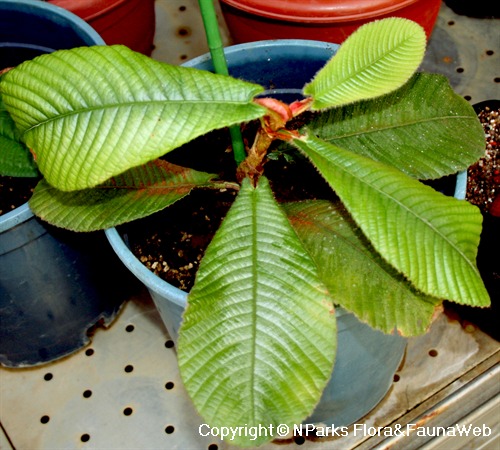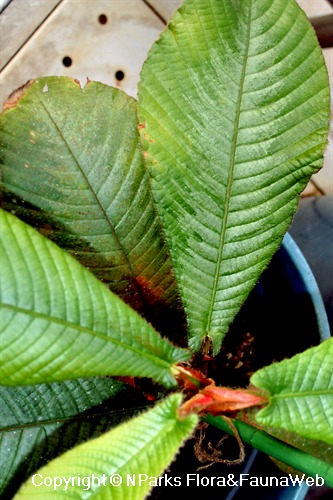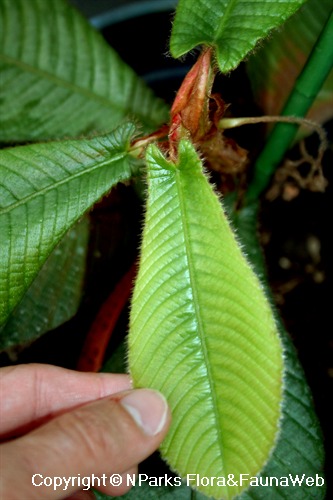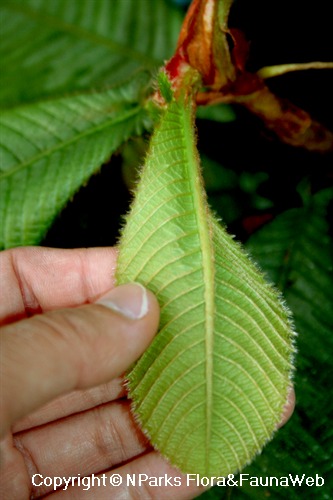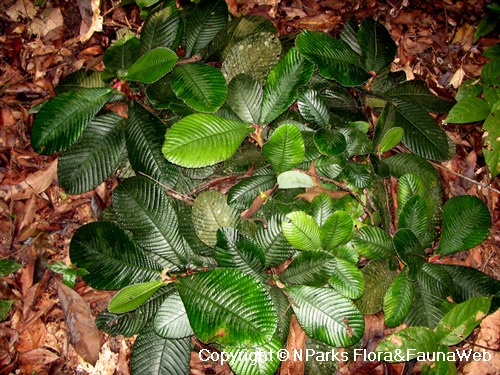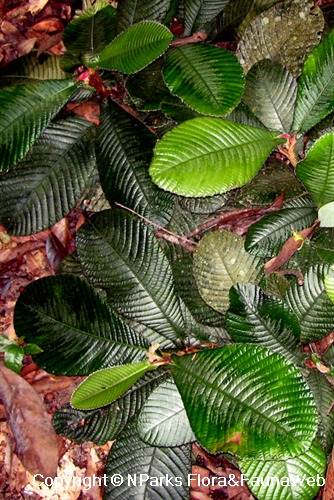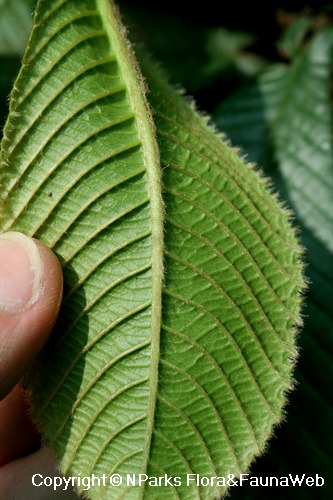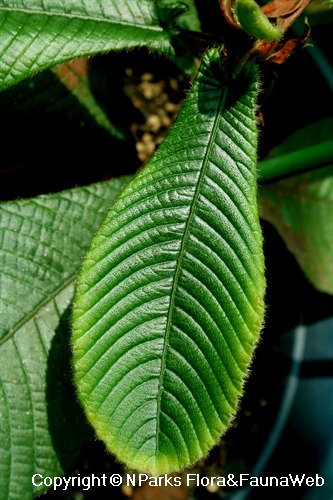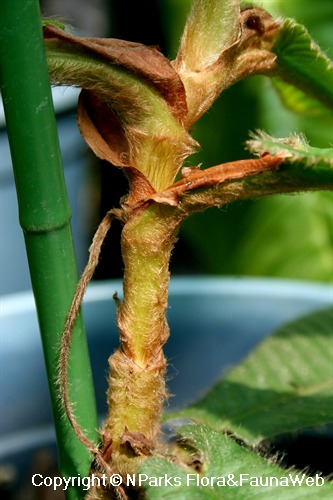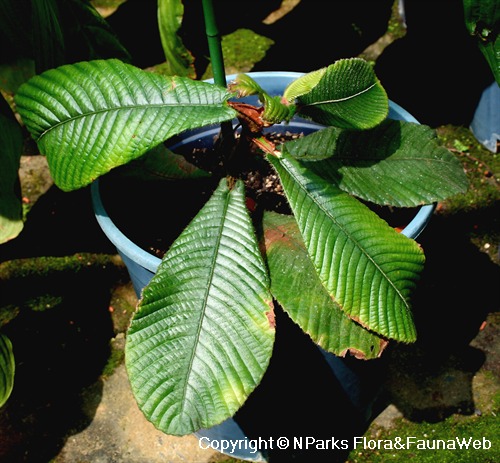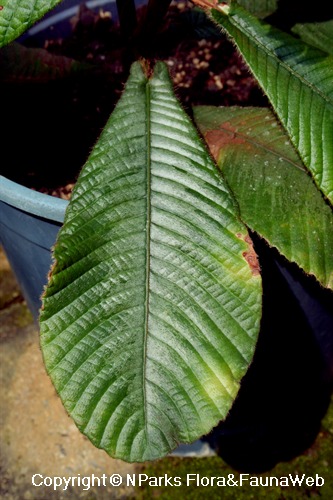.jpg)
Back
Acrotrema costatum Jack
| Family Name: | Dilleniaceae |
| Common Name: | Yellow Jungle Star, Tutup Bumi Rimba, Meroyan Punai Tanah, Punai Tunggal |
Name
Classifications and Characteristics
| Plant Division | Angiosperms (Flowering Seed Plants) (Dicotyledon) |
|---|---|
| Plant Growth Form | Herbaceous Plant, Creeper |
| Lifespan (in Singapore) | Perennial |
| Mode of Nutrition | Autotrophic |
| Plant Shape | Shrubby |
| Maximum Height | 0.2 m to 0.3 m |
Biogeography
| Native Distribution | Myanmar, Thailand, Peninsular Malaysia, Indonesia (Sumatra) |
|---|---|
| Native Habitat | Terrestrial (Secondary Rainforest, Monsoon Forest) |
| Preferred Climate Zone | Tropical, Sub-Tropical / Monsoonal |
Description and Ethnobotany
| Growth Form | Low-growing herbaceous shrub with short semi-woody stem, up to 30cm height. |
|---|---|
| Foliage | Mature leaves large (up to 16cm long), thick, distinctly and numerously veined, with tomentose abadxial nerves and toothed margins. Either totally green or variegated with a central feather-shaped silvery-grey stripe. Young leaves soft, densely tomentose on both surfaces, emerging reddish and aging to coppery and light green. Leaves crowded along short internodes, giving plant a rosette appearance. |
| Flowers | Yellow, 5-petaled, with densely-downy sepals. 8-12 flowers clustered on erect racemose inflorescence (7-15cm high) that is recurved towards the tip. |
| Fruit | Dehiscent capsules, containing up to 6 seeds. |
| Habitat | Found in undergrowth layer of lowland and hill forests or drier parts of freshwater swamp forests. Sole representative of the Acrotrema genus in Peninsular Malaysia, fairly widespread. |
| Cultivation | Withstands low light conditions. Avoid exposing to full sun to prevent leaf yellowing and burn. Provide moist but well-drained soils. Propagate by seeds or stem cuttings. |
| Etymology | Genus epithet 'Acrotrema' derived from Greek terms 'akros' (extremity, highest, terminal) and 'trema' (hole), probably referring to how young leaves and inflorescences emerge from the apical aperture at the top of the plant. Species epithet 'costatum' means 'ribbed', referring to the prominent venation and protruding nerves of the foliage. |
| Ethnobotanical Uses | Food (Herb or Spice) Others: Whole plant boiled in water and the decoction drunk as tonic by women after childbirh to prevent postpartum depression. Water from boiled roots used to treat menstrual problems in women, and lower backache in men. |
Landscaping Features
| Desirable Plant Features | Ornamental Foliage, Ornamental Flowers |
|---|---|
| Landscape Uses | Interiorscape/ Indoor Plant, General, Container Planting |
| Thematic Landscaping | Naturalistic Garden |
Plant Care and Propagation
| Light Preference | Semi-Shade, Full Shade |
|---|---|
| Water Preference | Moderate Water |
| Plant Growth Rate | Moderate |
| Rootzone Tolerance | Fertile Loamy Soils, Well-Drained Soils |
| Maintenance Requirements | Moderate |
| Propagation Method | Seed |
Foliar
| Foliage Retention | Evergreen |
|---|---|
| Mature Foliage Colour(s) | Green, Silver / Grey |
| Mature Foliage Texture(s) | Velvety / Furry / Tomentose, Raised / Sunken Veins, Thick |
| Foliar Type | Simple / Unifoliate |
| Foliar Arrangement Along Stem | Alternate |
| Foliar Shape(s) | Non-Palm Foliage (Obovate, Oblong) |
| Foliar Venation | Pinnate / Net |
| Foliar Margin | Serrate / Toothed, Dentate |
| Foliar Apex - Tip | Obtuse |
| Foliar Base | Sagittate |
| Typical Foliar Area | Mesophyll ( 45cm2 - 182.25 cm2 ) |
| Leaf Area Index (LAI) for Green Plot Ratio | 4.5 (Shrub & Groundcover - Dicot) |
| Prominent Young Flush Colour(s) Remarks | Reddish, Coppery, Light Green |
Non - Foliar and Storage
| Stem Type & Modification | Herbaceous |
|---|---|
| Root Type | Underground (Tap Root, Fibrous Root) |
| Specialised Storage Organ(s) | Underground |
Floral (Angiosperm)
| Flower & Plant Sexuality | Bisexual Flowers |
| Flower Colour(s) | Yellow / Golden |
|---|---|
| Flower Symmetry | Radial |
| Ovary Position | Superior / Hypogynous |
| Flowering Habit | Polycarpic |
Fruit, Seed and Spore
| Fruit Classification | Simple Fruit |
|---|---|
| Fruit Type | Dehiscent Dry Fruit , Capsule |
Image Repository
Others
| Master ID | 29430 |
|---|---|
| Species ID | 3739 |
| Flora Disclaimer | The information in this website has been compiled from reliable sources, such as reference works on medicinal plants. It is not a substitute for medical advice or treatment and NParks does not purport to provide any medical advice. Readers should always consult his/her physician before using or consuming a plant for medicinal purposes. |

.jpg)
